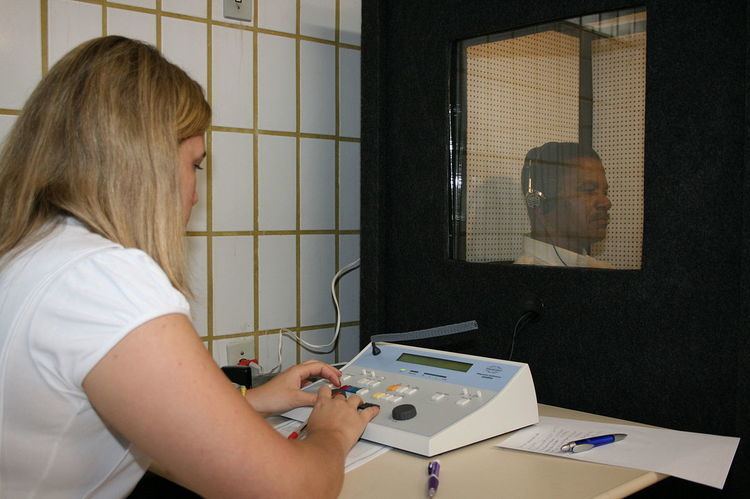ICD-9-CM 95.41 | ||
 | ||
A hearing test provides an evaluation of the sensitivity of a person's sense of hearing and is most often performed by an audiologist using an audiometer. An audiometer is used to determine a person's hearing sensitivity at different frequencies. There are other hearing tests as well, e.g., Weber test and Rinne test.
Contents
Ear examination
Prior to the hearing test itself, the ears of the client are usually examined with an otoscope to make sure they are free of wax, that the eardrum is intact, the ears are not infected, and the middle ear is free of fluid (indicating middle ear infection). The most common reasons to develop hearing loss due to genetic disorder, ageing problems, exposure to noise pollution, infections, birth complications, trauma to the ear, and certain medications or toxins.
Pure tone audiometry
The standard and most common type of hearing test is pure tone audiometry, which measures the air and bone conduction thresholds for each ear in a set of 8 standard frequencies from 250Hz to 8000Hz. The test is conducted in a sound booth using a pair of headphones connected to an external audiometer. The result of the test is an audiogram diagram which plots a person's hearing sensitivity at the tested frequencies. There is also a high frequency version of the test which tests frequencies over 8000Hz to 16000Hz which may be employed in special circumstances.
Weber and Rinne
A complete hearing evaluation involves several other tests as well. In order to determine what kind of hearing loss is present, a bone conduction hearing test is administered. In this test, a vibrating tuning fork is placed behind the ear, on the mastoid process. When the patient can no longer feel/hear the vibration, the tuning fork is held in front of the ear; the patient should once more be able to hear a ringing sound. If they cannot, there is conductive hearing loss in that ear. Additionally, the tuning fork is placed on the forehead. The patient is then asked if the sound is localised in the centre of the head or whether it is louder in either ear. If there is conductive hearing loss, it is likely to be louder in the affected ear; if there is sensorineural hearing loss, it will be quieter in the affected ear. This test helps the audiologist determine whether the hearing loss is conductive (caused by problems in the outer or middle ear) or sensorineural (caused by problems in the cochlea, the sensory organ of hearing) or neural - caused by a problem in the auditory nerve or auditory pathways/cortex of the brain.
Hearing in Noise
The Hearing in Noise Test (HINT) measures a person's ability to hear speech in quiet and in noise. In the test, the patient is required to repeat sentences both in a quiet environment and with competing noise being presented from different directions. More specifically, there are four conditions: (1) sentences with no competing noise, (2) sentences with competing noise presented directly in front of the patient, (3) noise presented at 90° to the right of the patient, and (4) noise presented at 90° to the left of the patient. The test measures signal to noise ratio for the different conditions which corresponds to how loud the sentences needed to be played above the noise so that the patient can repeat them correctly 50% of the time.
